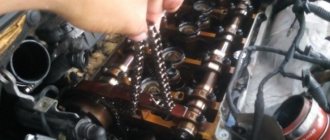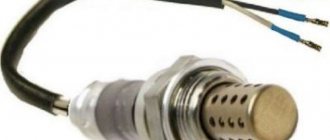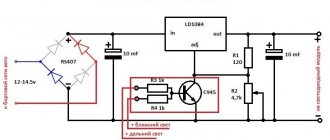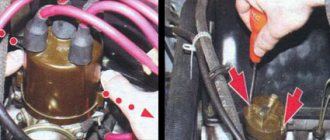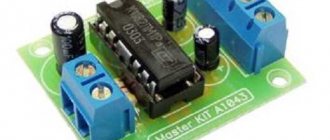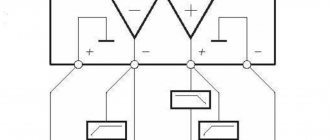The operation of powerful car subwoofers may be accompanied by problems associated with the high current consumption of these devices. You can notice this at low frequency peaks, when the subwoofer “chokes.”
This is explained by voltage drops at the subwoofer power input. An energy storage device, the role of which is played by the capacitance of a capacitor connected to the subwoofer power circuit, helps to correct the problem.
Why do you need a capacitor for a subwoofer?
An electrical capacitor is a two-pole device capable of accumulating, storing and releasing electrical charge. Structurally, it consists of two plates (plates) separated by a dielectric. The most important characteristic of a capacitor is its capacitance, which reflects the amount of energy that it can accumulate. The unit of measurement for capacitance is the farad. Of all types of capacitors, electrolytic capacitors have the highest capacity, as well as their further improved relatives - ionistors.
To understand why a capacitor is needed, let’s figure out what happens in the car’s electrical network when low-frequency car acoustics with a power of 1 kW or more are connected to it. A simple calculation shows that the current consumed by such devices reaches 100 amperes or more. The load is uneven, the maximums are reached at the moments of bass hits. The voltage drop when the car audio passes through the peak of the bass volume is caused by two factors:
- The presence of internal resistance of the battery, limiting its ability to quickly release current;
- The influence of the resistance of the connecting wires, causing a voltage drop.
The battery and capacitor are functionally similar. Both devices are capable of storing electrical energy and subsequently releasing it to the load. The capacitor does this much faster and more readily than the battery. This property underlies the idea of its application.
The capacitor is connected in parallel to the battery. With a sharp increase in current consumption, the voltage drop across the internal resistance of the battery increases and, accordingly, decreases at the output terminals. At this moment the capacitor comes into operation. It releases the accumulated energy, and thereby compensates for the drop in output power.
How to choose a capacitor
The required capacitor capacity depends on the power of the subwoofer. In order not to go into complex calculations, you can use a simple rule of thumb: for 1 kW of power, a capacitance of 1 farad is required. Exceeding this ratio is only beneficial. Therefore, the most common high-capacity capacitor on sale, 1 farad, can also be used for subwoofers with a power of less than 1 kW. The operating voltage of the capacitor must be at least 14 - 18 volts. Some models are equipped with a digital voltmeter indicator. This creates additional ease of use, and electronics that control the charge of the capacitor make this procedure easier.
How to connect a capacitor to a subwoofer
Installing a capacitor is not a complex procedure, but when performing it you need to be careful and follow some rules:
- To avoid a noticeable voltage drop, the wires connecting the capacitor and the amplifier should not be longer than 50 cm. For the same reason, the cross-section of the wires must be chosen large enough;
- Polarity must be observed. The positive wire from the battery is connected to the positive power terminal of the subwoofer amplifier and to the capacitor terminal marked with a “+” sign. The capacitor terminal marked “-” is connected to the car body and to the negative terminal of the amplifier power supply. If the amplifier was previously connected to ground, the negative terminal of the capacitor can be clamped with the same nut, while maintaining the length of the wires from the capacitor to the amplifier within the specified limits of 50 cm;
- When connecting a capacitor to an amplifier, it is better to use standard clamps to connect wires to its terminals. If they are not provided, you can use soldering. Twisted connections should be avoided as significant current flows through the capacitor.
Figure 1 illustrates the connection of a capacitor to a subwoofer.
How to charge a capacitor for a subwoofer
To connect to the car's electrical network, an already charged car capacitor should be used. The need to perform this action is explained by the properties of the capacitor, which were mentioned above. The capacitor charges as quickly as it discharges. Therefore, at the moment the discharged capacitor is turned on, the current load will be too high.
If the purchased subwoofer capacitor is equipped with electronics that control the charging current, you don’t have to worry; feel free to connect it to the power circuits. Otherwise, the capacitor should be charged before connection, limiting the current. It is convenient to use an ordinary car light bulb for this, turning it on against the power supply circuit. Figure 2 shows how to properly charge large capacitors.
At the moment of switching on, the lamp will light up at full intensity. The maximum current surge will be limited by the power of the lamp and will be equal to its rated current. Further, during the charging process, the glow of the lamp will weaken. At the end of the charging process, the lamp will go out. After this, you need to disconnect the capacitor from the charging circuit. Then you can connect the charged capacitor to the amplifier's power supply circuit.
If after reading the article you still have questions about connection, we recommend that you read the article “How to connect an amplifier in a car.”
Brief overview of capacitor models
From the information provided, it is clear that capacitors differ in capacity, set of functions, and equipment. Accordingly, the price category of devices ranges from about forty dollars per unit of goods and can reach three hundred dollars per device.
Autofun CAP-10 is one of the simplest and most affordable devices. The cost is about forty dollars, the device capacity is 1 farad, the operating temperature is up to 95 degrees. It is in demand among buyers due to its attractive price.
Autofun CAP-10
Hollywood brand capacitors are also in demand among customers. The price range of models of this brand is from fifty dollars to two hundred per unit, depending on the capacity of the device and additional functions.
Hollywood brand capacitor
The Signat ECC1 is a small device, although it has attractive characteristics. Capacity - 1 farad, price about two hundred and fifty conventional units.
Signat
The Brax IPC is a reasonable power capacitor that costs over three hundred dollars. This device has super-powerful electrical characteristics; the operating principle is based on automation. There is practically no internal resistance in the capacitor.
Brax IPC
And one more rule. For devices, a characteristic feature is the correspondence between the price and quality of the device. The more expensive the product you purchase, the more reliable it will be in operation.
Subwoofer capacitors are very easy to install, so you don’t need the help of a specialist. You can handle this task yourself by following the simple instructions that come with the device.
Autofun CAP-10 is one of the simplest and most affordable devices. The cost is about forty dollars, the device capacity is 1 farad, the operating temperature is up to 95 degrees. It is in demand among buyers due to its attractive price.
The Signat ECC1 is a small device, although it has attractive characteristics. Capacity - 1 farad, price about two hundred and fifty conventional units.
The Brax IPC is a reasonable power capacitor that costs over three hundred dollars. This device has super-powerful electrical characteristics; the operating principle is based on automation. There is practically no internal resistance in the capacitor.
The best prices and conditions for the purchase of new cars
Many car enthusiasts who have installed a subwoofer in their car are seriously puzzled by the issue of a capacitor for a subwoofer. It would be more correct to say a capacitor for an audio system, but since such a concept as a capacitor for a subwoofer has taken root, we will use it.
So the main question is - is it necessary or not? It’s definitely needed, but is it worth spending money on it, because this thing is quite expensive. Unfortunately, there is no clear answer to this question even among professionals. Many people believe that it is better to spend money on power wires with a larger cross-section and a more capacious battery.
And again BUT appears. Power wires and a powerful battery can only fight up to a certain limit, and beyond that...the capacitor comes into play.
“The amplifier is connected to a powerful power source - a generator and a battery. Connected with proportionally powerful wires that would make an electric welder jealous. What more could an amplifier want? And he desires, even demands. It requires not only the amount of energy, but also the speed at which it enters its aluminum belly.
After all, he has to amplify not a smooth hum, but a musical signal, pulsed in nature. And so, when that same cherished and dramatic explosive chord came to the entrance, the device discovered that lighter gasoline, even when there is a lot of it, cannot burn faster than a certain speed. A powerful current pulse, which at this moment passes through the entire power circuit, melts and is smeared by the voltage drop across the wires, terminals, connectors, and is lost at the internal resistance of the battery.
Read more: New warning triangle - how to choose and why you need it
Life, of course, is not a magazine; a lot of operational issues come into play in it, for example, a generator. There have been cases where, after installing a subwoofer, the generator failed, and the reason is most likely not only due to the increased load. The reason is constant voltage drops, when the entire electrical system fluctuates in time with the dynamic load of the subwoofer. I won’t even talk about drained batteries when listening to music when the car is not running.
Let's return to the capacitor for the subwoofer. From the stories and descriptions it is easy to understand what he is like, but it is still better to see once than to hear a hundred times.
The circuit uses an 8 farad capacitor and a 12-inch DLS subwoofer plus a three-band front. So the peak current consumption reached 28A. Which is equal to 390W! (in the case of direct current, simply multiply volts by amperes) In this case, the voltage drop is visible on the instruments. In reality, the drawdown should be greater, because devices simply do not have time to track sudden changes in voltage. But everything is quite smooth. so draw your own conclusions.
Despite the English notations, everything is quite clear. It is only worth noting that to improve sound quality, it is worth connecting the mass going to the capacitor (as well as ““) with a wire, and not using the car body.
In recent years, it is increasingly possible to find subwoofer drives that use capacitors (from the Latin condense). If previously such a filter for a subwoofer was found only in top-level systems, today they can increasingly be found in budget installation options. Let's try to figure out on our website why a condenser is needed in a car audio system. A modern active subwoofer can cause short-term problems while playing music. peaks consume significant current.
Even the most powerful car batteries cannot provide such current power. Without the use of a condenser, at these moments there are dips in the operation of the subwoofer, which significantly deteriorates the sound quality. It is to solve the problem of voltage accumulation that capacitors are used.
The main purpose of this component is to accumulate charge, which, if necessary, is given to the amplifier for the subwoofer. After the discharge is released, the capacitor is charged again for a new subwoofer bass. All this happens in a split second, which allows for high-quality sound.
Even in budget installations with a subwoofer, the sound quality improves dramatically. The unpleasant, indistinct muttering of the subwoofer that appears during voltage dips disappears.
Electrical diagram for connecting a capacitor to a subwoofer
The electrolytic capacitor is connected in parallel to the subwoofer and the battery, the capacitance of the capacitor is selected experimentally to be no less than 60,000-65,000 uF.
Appearance of one of the brands of capacitors
Now let's look at capacitor models that we think are interesting and that are recommended to be installed with a subwoofer. Let's start with the most expensive and best, according to experts. Let us note right away that all popular models are not included in this article (detailed reviews of capacitors can be read in other articles on our website).
Brax IPC
Capacitor costing 300 US dollars. The model name IPC stands for “intelligent power capacitor.” It has the following features:
- The user will find in this model a luxurious, superbly finished, clearly thought out device with the highest electrical performance;
- The length of the capacitor body is 280 mm, and the diameter is 75 mm;
- The operating principle is based on automation, which will provide charging with a normalized current and protect the acoustics from overvoltage;
- The Brax capacitor operates at 17.5 V, if connected incorrectly, automatically connected to the power network and disconnected;
- Provides continuous indication of voltage at the amplifier terminals (see);
- The capacitor is made in a stylish, beautiful case with a transparent head, in the center of which a 3-charge digital indicator is displayed. This indicator becomes active as soon as it senses the slightest voltage ripple on the amplifier and shows a voltage of up to 0.1 V;
- The capacitor readings are not carried out by continuous blinking, as on some cheap models, but are averaged with a time constant of about 1.5 s;
- For rapid fluctuations, the answer is another indicator, operating on 2 LEDs. If one of them or two blinks at once, this indicates short-term voltage ripples;
- There is also a third indicator called CPS. It is needed to report danger: if it lights up red, the polarity is reversed; if it lights up yellow, the overvoltage protection has tripped.
In a word, this is a gorgeous device that we recommend everyone buy. In addition to purely intellectual capabilities, this capacitor has virtually no internal resistance and it passes through at a record low.
An excellent electronic capacitor with declared internal resistance characteristics. The approximate price of the device is $250. It has the following features:
- Stated internal resistance characteristics: 1.8 mOhm/120 Hz and 1 mOhm/20 kHz;
- The advantages of this capacitor will be fully manifested in conjunction with a high-quality amplifier (where power supplies, as a rule, operate at a higher frequency);
- The head of the device is filled with electronics, which ensures smooth charging in 10 seconds;
- You can know that charging is in progress by the blinking indicators;
- If the voltage in the network crosses the value limit of 15.5 V, the protection is triggered immediately. If the voltage drops (11 V), the capacitor turns off and goes into hibernation.
Signat ECC1
Automotive capacitor for $230. Extremely compact, despite its record performance. Features:
- The model is made in a traditional dark blue case, with a diameter of 70 mm (the usual size of capacitors in other models is 75 mm);
- The top or head of the device, as is commonly seen on high-end capacitors, houses the electronics. It is able to provide a fully automated charging procedure in just 1 minute. We are talking about a current of 500 mA;
- You can find out about the charging process by the LEDs that light up. There are 5 of them of different colors, from red to green, and they glow alternately. You should know that when the last fifth indicator lights up, this indicates that the capacitor is fully charged.
- Voltage fluctuations are controlled by the same LEDs that monitor the charging of the device. When the voltage fluctuates, they go out one by one;
- There are two more separate LEDs. One of them is designed to indicate whether the connection to the power circuit has occurred, and the other reacts if there is an error in the polarity connection.
- The ECC1 signal is designed so that the operation of the device can be observed from two positions: either through a transparent wall or from above, where there are translucent windows;
Brax IPC
Additional benefits of installing capacitors in cars
In addition to solving problems with the operation of the subwoofer, a capacitor connected to the car network has a positive effect on the operating mode of electrical equipment as a whole. This manifests itself as follows:
general information
The best capacitors for acoustics
So why do you need a capacitor? As you know, the price for it is not small and not all motorists, even lovers of good sound, want to cut their budget once again. On the other hand, every music lover sooner or later acquires a powerful speaker system or brings it to perfection. This is very good, but the more powerful the system, the more energy you give it.
Note. The battery is not capable of delivering such energy, as a result of which a drawdown occurs (what this means is described in detail below). The drawdown is expressed by the fact that the car’s headlights begin to “blink,” the amplifier’s power drops, and the bass coming from the subwoofer, which was previously clear, becomes “blurry.” In some and especially severe cases, a sharp drop in amplifier voltage leads to clipping, which can damage the speakers.
A little about capacitors
This is what a modern subwoofer drive looks like
Nowadays, subwoofer drives that use capacitors are increasingly common, photo above (from the Latin Condense - to accumulate):
- Previously, such filters for subwoofers were found only in sophisticated top-level systems, but today they are increasingly found among budget installation options
- Now let’s take a closer look at why a capacitor (hereinafter referred to as a condenser) is so necessary in a car’s audio system.
- Today, a modern active subwoofer consumes significant (increased) current when playing music at short-term sound peaks
- However, even the most powerful batteries will not be able to provide the required current power today.
- Without the use of condensers, at these moments there are noticeable dips in the operation of the subwoofer, which significantly reduces its sound quality. To solve problems with the accumulation of additional voltage, drives are used
- The main purpose of this part in the circuit is to accumulate charge, which, if necessary, is sent to the network to the amplifier for the subwoofer
- Immediately after the charge is released, the capacitor is charged again (see How to charge a subwoofer capacitor yourself) to provide a new bass peak for the subwoofer
- The installation diagram of the subwoofer and capacitor is shown in the first figure
- The entire process takes place in a fraction of a second, allowing you to consistently provide high-quality sound
- Moreover, even in cheap installations using a subwoofer, the sound quality improves dramatically
- The indistinct muttering that is so unpleasant for everyone, which occurs when there is a dip (lack of voltage), immediately disappears
- Is this capacitor really necessary?
- After all, it is known that the price for it, alas, is not small, so not every motorist, even among lovers of high-quality sound, can afford such a luxury
- But on the other hand, almost every music lover sooner or later acquires powerful musical equipment and brings its sound to perfection
- Sound power is good, but the more powerful your system, the more power it requires.
- To this day, there are heated discussions on the Internet, on forums, blogs and websites regarding the need or uselessness of such a drive.
- These disputes, to the great regret of all lovers of good car audio, do not lead to the truth (“in a dispute, truth dies” - as the ancient Greek philosopher said)
- They are useless, simply because often opponents do not even have a basic, “school” understanding of the physics of the ongoing processes
- To open the veil at least to some extent, let's now return to physics lessons
- And as useful knowledge is updated (refreshed) in our memory, all myths will dissipate like morning fog
True or not
To this day, on the Internet, in various forums and blogs, there are heated debates regarding the need or uselessness of such a storage device as a capacitor. The debates themselves, to the great regret of car audio lovers, do not lead to any truth. They are completely useless, due to the fact that opponents do not even have a basic school understanding of physics.
Note. The biggest nonsense that can be read from forums is that you need to install a capacitor based on only farads per kilowatt. Such recommendations are fundamentally wrong, since you will not understand where they came from.
So, to lift the veil somewhat, let's go back to our physics lessons. As valuable knowledge is updated in our memory, all myths will disappear like morning smoke.
Differences between a capacitor and a battery
- A capacitor for a woofer is the same power consumer that is not capable of generating electricity itself. But it is capable of accumulating it and then consuming it for its own leaks, but not for battery leaks;
- The capacitor's task is to accumulate energy and then release it to the consumer. The drive itself has extremely low internal resistance and for this reason “parts” with energy very quickly (by the way, it does not accumulate it slowly either).
Note. The difference between a capacitor and a battery is that the peak energy output of a capacitor occurs only for the first moment, and then there is a sharp drop in charge. Thus, the recoil speed drops along with the charge.
Differences between a capacitor and an ionistor
Capacitor for subwoofer
Ionistors are what most music lovers carry in their trunks. It differs from a capacitor in the following parameters:
- Huge losses;
- Greater resistance;
- Releases charge much more slowly;
- It costs several times less than a capacitor of the same capacity.
The optimal operating time of the ionistor is: 1 sec/83 cool.
Checking the ionistor
It is recommended to check the ionistor to clearly understand how it works:
- We connect the ionistor to the speaker system with power drawdowns;
- We start it up and observe that the voltage at the terminals increases. So far so good;
- We increase the volume and notice that the voltage drops from 13 to 10 volts.
Note. All this means that at the first hit of the subwoofer, the charge will drop and the ionistor will turn into an extra power component, since it is useful and active only when its charge is greater than the voltage in the network.
This situation among car audio enthusiasts is called sag, but it can be much worse if thin, low-quality wires and cheap copper-plated aluminum are used in the power supply. In this case, cable subsidence is also added to the normal subsidence.
Note. You need to know the dangers of cable sag. The fact is that with a sharp increase in consumption, reactance occurs. The more and faster the user tries to take energy from the cable, the more it (the cable) will interfere with this (if it is thin and long).
The problem of a cheap and low-quality cable will also be reflected in the ionistor, which, having discharged, will no longer be able to receive energy.
Physical processes occurring in a capacitor
1 We know that oppositely charged charges attract each other, if we ensure the connection of potentials with charges, then a discharge will occur. But if we just bring one charge to another, then more significant forces of attraction to each other will appear between the charges as a result of the reduction in distance. In a capacitor, electrically conductive plates are located one parallel to the other, separated by a dielectric and collect oppositely charged charges, but due to the high resistance of the dielectric, they cannot be discharged instantly. 2 Nevertheless, even through this dielectric the capacitor can be discharged. The better the capacitor is made, the longer the difference of previously charged different potentials will remain on its plates. 3 The capacitor is designed for a specific voltage. This depends on the design and materials used. A higher voltage can break through the dielectric and thereby disrupt the entire design of the operation and, as a result, damage the capacitor. The plates can accommodate a certain charge potential; this potential of the capacitor is actually characterized by its capacitance. This depends on the size of the plates and their location.
CHAPTER ONE what capacitor capacity should be used for my equipment
And so the basics are there, developing the above-mentioned axioms about the operation of a capacitor, one can draw conclusions about where capacitor manufacturers and consumers should strive when choosing a capacitor to power the audio equipment of their car (car radio, subwoofer, amplifier).
Voltage dips often occur in a car. This is due to the inability to produce a certain power, as a result of a short-term jump in the increase in power consumption when playing music, usually with low frequencies. The fact is that low frequencies at the input to amplifier stages for a long time, relative to high frequencies, open up the semiconductor permeability of the electronic transitions of transistors in the amplifier stages, thereby reducing the load resistance for the power supply and increasing short-term power consumption. Installing a capacitor in a car is actually an empirical (determined by experience) dependence, since the spectrum of reproduced frequencies will require different power modes, but with the knowledge of one thing that you can’t spoil the porridge with oil. Therefore, when choosing a capacitor for a subwoofer or radio, I do not recommend choosing a capacitance of less than 60,000-65,000 uF. Or, if you like, the capacitor capacity can be determined using the formula - 1 farad of capacitor capacity per kilowatt of load power.
Condenser installation
When installing a capacitor, it is recommended to connect it in parallel with the power supply of the amplifier (see How to connect an amplifier to a car radio: you are your own master). It must be placed as close as possible to the power amplifier, at least no further than 60 cm. If you put a capacitor in place of the ionistor, the result will be much more effective. Everything is done like this:
- The car generator is repaired or a new one is installed;
- A cable is laid from it to ground and plus;
- A new battery is installed;
- All terminals are changed or thoroughly cleaned;
- A good quality power copper cable with a sufficient cross-section is laid;
- We connect the amplifier, do not forget the fuse.
Advice. Until we check all the terminals and make sure that there is 14 volts, we do not connect the capacitor.
- After everything has been checked, you can connect the capacitor. Measurements at the terminals will show the same results, but you shouldn’t be surprised. If the circuit is “live” and there is enough power, then the capacitor has nothing to turn on and it seems to be waiting in the wings.
Note. Another misconception is the fact that supposedly a capacitor is needed in systems where high volume is required or in SPI El competitions. In normal cases, a capacitor will successfully replace an ionistor.
You can prove the need for a capacitor in conventional car speaker systems based on the following:
- Measuring the capacitor can last a long time, and this will “wake up” even the most acidic battery and thus be able to give up its full potential;
- Among the so-called espi ale fraternity, the use of gel batteries, capable of “shooting” hundreds of amps with amazing speed, is more common. No matter how much we praise the capacitor, at such a speed it will “feel” clearly out of work;
- Again, regarding the espi el, the capacitor is out of place, since it is an energy consumer, which is clearly evil for the espi el.
In a word, the ESPI EL certainly does not use any capacitor or other storage device.
Installation and charging
This procedure is not something very complicated.
Read more: How to check a lambda probe - 125 photos and ways to check it yourself in a garage
Note. An interesting and noteworthy fact is that the battery is rarely the owner's attention while the car is starting. As soon as problems begin, the owner begins to sound the alarm.
The condition of the battery, of course, especially with the onset of cold weather, deserves more careful attention, but still, even if it is new and fully operational, it will definitely need the help of a capacitor (see Why is a capacitor needed for car audio today) in a car where there is a powerful subwoofer.
Detailed and step-by-step instructions on how to do this are provided here:
- First, you should prepare: find a DC source (battery in this case), a resistor (it comes with the capacitor) or a 12 V light bulb (if you couldn’t find a resistor) and wires for connecting the capacitor (they should be of the same cross-section, as well as power cables).
Advice. When carrying out the charging process, it is still advisable to use a 12 V light bulb, since everything will appear more clearly. The light will light up during charging, and after the capacitor is fully charged, it will go out.
- Next, make sure that the positive terminal of the capacitor is connected to the amplifier correctly (plus to the amplifier power wire).
Note. As for the negative terminal of the capacitor, it must be connected to the “ground” of the car (body).
- Carefully turn off the fuse for the speaker system;
- Remove the wire from the positive terminal of the capacitor;
- We connect the battery to the network (you can learn how to do this from thematic articles);
- We take a resistor or a light bulb, connect one contact to the positive terminal of the drive, and the other to the power wire (charging time is determined by the manual, instructions included in the kit);
Capacitor for subwoofer
- put back the fuse for the speaker system;
- wait as long as necessary (at least 2 minutes), then turn off the resistor;
- We connect the drive's power cable to the positive terminal directly.
Advice. It is not recommended to tighten the terminals too much, as this will lead to undesirable consequences.
Diagram of how to charge a capacitor
Why do you need a capacitor for a subwoofer?
Thus, we explained why this component is needed in a car. Now let's move on to the useful topic of how to install and connect a capacitor.
Installation
The installation process itself has the following features:
- The capacitor is installed no further than half a meter from the amplifier to avoid a decrease in the amplitude of the current due to the resistance of the connecting wires;
- In no case should you skimp on a capacitor, and if you decide to install it, it must be a high-quality one, and not some Chinese one, so that it will be of any use.
- If there is still no electronic circuit in the capacitor, then it is recommended to initially recharge the element with a 12-volt light bulb;
- Interestingly, you can install a capacitor in a system of any power, regardless of the number of amplifiers.
Read more: Kia Rio dashboard - What is the Supervision dashboard on the Kia Rio, description and symbols of icons with photos
Charger
As for charging the capacitor (see How to charge a capacitor for a subwoofer yourself), then, as mentioned above, it is useful to charge with a 12 V light bulb, which will let the user understand how the process goes. It itself implies the following:
- A light bulb or resistor (preferably a 12 V light bulb) is connected to the battery positive on the wire;
- The other end of the wire is connected to the positive terminal of the capacitor;
- During the charging process, if the capacitor has a display with a light indication, it will light up. The voltmeter value on the capacitor will also increase, but as soon as it stops, charging must also be completed;
- Remove the light bulb or resistor.
The best capacitors
Which capacitor is better for acoustics?
Today, there are a lot of capacitors, like any other car audio products, on the market. Some amplifier manufacturers even provide terminals in advance for connecting a capacitor.
Note. Such amplifiers include the Audison Vesis HV Venti, which was even recognized as the best acoustic amplifier of last year.
